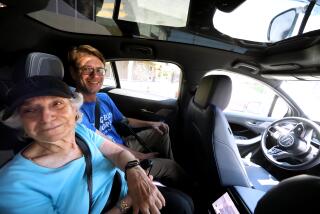Q&A: Daimler trucks chief devotes $572 million to driverless technology
Daimler said Monday that it will spend half a billion euros, or about $572 million, to develop driverless trucks.
The German giant, parent company of Mercedes Benz, also manufactures several truck brands, including Freightliner. Starting this year, Freightliner Cascadia big rigs will be fitted with driver-assist technologies such as adaptive cruise control operating at highway speeds. Martin Daum, chief of trucks and buses at Daimler, made the announcement at CES, the big consumer technology trade show in Las Vegas.
While Daimler throttles up for driverless technology, however, it’s putting the brakes on platooning. That’s when several trucks line up tightly together, similar to the aerodynamic technique used by bicycle racers, but aided by sensors and computers. Daimler testing has shown that platooning uses more fuel than it saves because of the acceleration needed to catch up with the pack when the platoon chain is broken.
The Los Angeles Times chatted with Daum about the coming shift to robot drivers.
Why build driverless trucks?
This is part of the evolution of the truck business. We’ve been working for 120 years to make them better and better. We want to use the best available tools. That is our motivation.
When will driverless cars be common on U.S. highways?
If we look at the entire North American highway system, within the next 10 years it will be normal. Between two cities, without a driver other than someone observing inside the truck, it’s difficult to say, but I’d guess four to 10 years.
How will that impact truck driver jobs?
We have 4 million trucks now on North American roads. If we added 100,000 autonomous trucks, it’s still a small part of the spectrum. And these days there is a big shortage of drivers. We need more drivers every year.
This will be a natural evolutionary change. The impact on the workforce will be fairly limited.
People might be freaked out seeing trucks on the road with no human driver.
We are not going to compromise on safety. We’ll be ready to launch when we are absolutely convinced not only that this is not a hazard, but will reduce accidents and casualties.
Even if driverless vehicles are safer, the media will naturally jump on a robot truck involved in a crash.
This is one of the problems we have to solve. It’s an acceptance question and a media question as well. If society is not accepting [of the lives saved] and focuses on one accident by one machine, we’ll never see these trucks on the road.
There aren’t enough statistics yet to conclusively prove that driverless cars are significantly safer.
Without trying it, with a lot of safety precautions, we’ll never get an answer to these questions.
We need to have very open communications. We’re not hiding out. If it’s not working, we’ll pull the plug, like we did with platooning.
Twitter: @russ1mitchell







